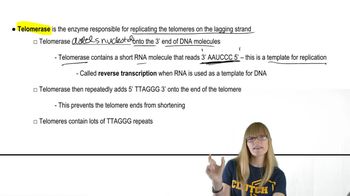There is a problem completing the replication of linear chromosomes at their ends. Describe the problem and identify why telomeres shorten in each replication cycle.
Table of contents
- 1. Introduction to Genetics51m
- 2. Mendel's Laws of Inheritance3h 37m
- 3. Extensions to Mendelian Inheritance2h 41m
- 4. Genetic Mapping and Linkage2h 28m
- 5. Genetics of Bacteria and Viruses1h 21m
- 6. Chromosomal Variation1h 48m
- 7. DNA and Chromosome Structure56m
- 8. DNA Replication1h 10m
- 9. Mitosis and Meiosis1h 34m
- 10. Transcription1h 0m
- 11. Translation58m
- 12. Gene Regulation in Prokaryotes1h 19m
- 13. Gene Regulation in Eukaryotes44m
- 14. Genetic Control of Development44m
- 15. Genomes and Genomics1h 50m
- 16. Transposable Elements47m
- 17. Mutation, Repair, and Recombination1h 6m
- 18. Molecular Genetic Tools19m
- 19. Cancer Genetics29m
- 20. Quantitative Genetics1h 26m
- 21. Population Genetics50m
- 22. Evolutionary Genetics29m
8. DNA Replication
Telomeres and Telomerase
Problem 26b
Textbook Question
Telomeres are found at the ends of eukaryotic chromosomes. How does telomerase assemble telomeres?
 Verified step by step guidance
Verified step by step guidance1
Understand that telomeres are repetitive DNA sequences at the ends of eukaryotic chromosomes, which protect the chromosome from degradation during replication.
Recognize that during DNA replication, the lagging strand synthesis cannot fully replicate the ends of linear chromosomes, leading to progressive shortening of telomeres.
Learn that telomerase is an enzyme that counteracts this shortening by adding repetitive nucleotide sequences to the ends of chromosomes. Telomerase is a ribonucleoprotein, meaning it contains both a protein component and an RNA template.
Explore how telomerase uses its RNA template to extend the 3' overhang of the DNA strand. The RNA template within telomerase is complementary to the telomeric repeat sequence, allowing it to base-pair with the DNA and serve as a guide for nucleotide addition.
Understand that after telomerase extends the 3' overhang, conventional DNA polymerase and primase can synthesize the complementary strand, completing the telomere extension process and maintaining chromosome integrity.
 Verified video answer for a similar problem:
Verified video answer for a similar problem:This video solution was recommended by our tutors as helpful for the problem above
Video duration:
2mPlay a video:
Was this helpful?
Key Concepts
Here are the essential concepts you must grasp in order to answer the question correctly.
Telomeres
Telomeres are repetitive nucleotide sequences located at the ends of eukaryotic chromosomes. They protect the chromosome from deterioration or fusion with neighboring chromosomes, which is crucial for maintaining genomic stability. Each time a cell divides, telomeres shorten, which is associated with aging and cellular senescence.
Recommended video:
Guided course

Telomeres and Telomerase
Telomerase
Telomerase is an enzyme that adds nucleotide sequences to the ends of telomeres, counteracting their shortening during cell division. It is composed of a protein component and an RNA template that guides the addition of DNA repeats. Telomerase activity is typically high in stem cells and cancer cells, allowing them to divide indefinitely.
Recommended video:
Guided course

Telomeres and Telomerase
Mechanism of Telomere Assembly
The assembly of telomeres by telomerase involves the enzyme binding to the existing telomere and extending it by adding specific DNA sequences. This process is crucial for maintaining telomere length and ensuring that genetic information is preserved during cell division. The mechanism is vital for cellular longevity and plays a significant role in cancer biology.
Recommended video:
Guided course

Telomeres and Telomerase

 8:38m
8:38mWatch next
Master Telomeres and Telomerase with a bite sized video explanation from Kylia
Start learningRelated Videos
Related Practice
Textbook Question
473
views
